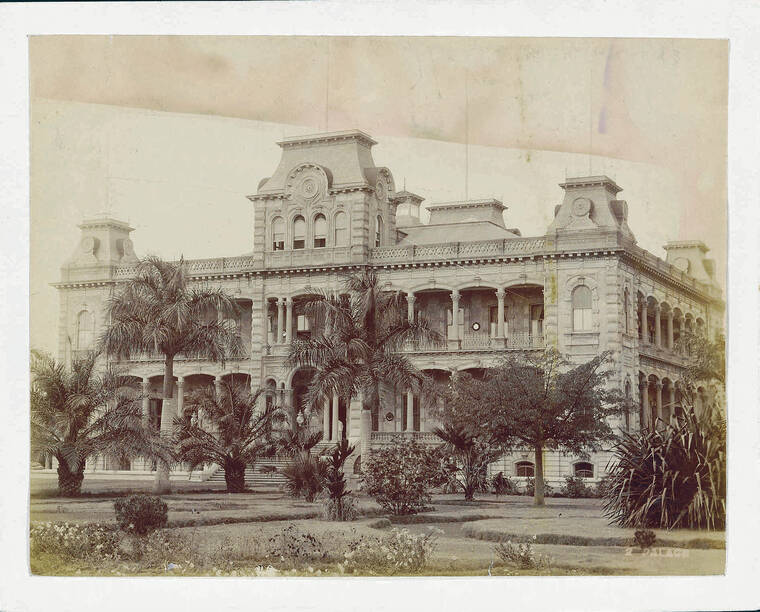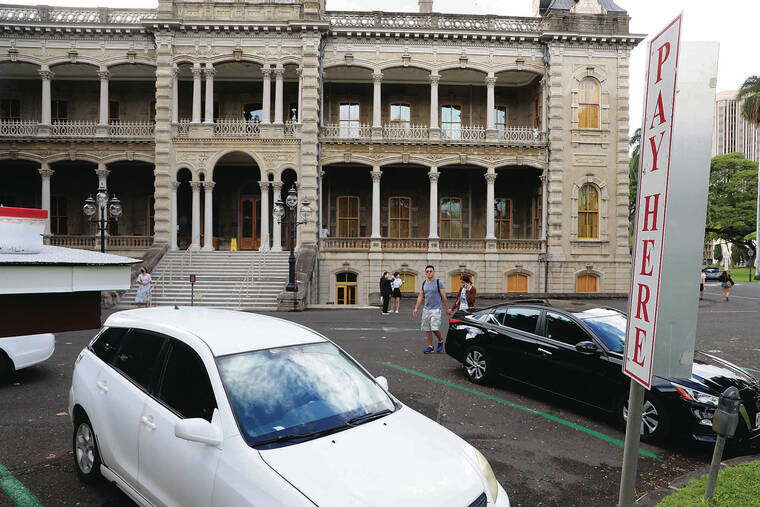Not-so-regal parking eyed for removal at Iolani Palace

STAR-ADVERTISER FILE
Iolani Palace, pictured here in the 1890s, used to feature gardens around its exterior. Now the palace is surrounded by an asphalt parking lot lined with more than 100 stalls.

JAMM AQUINO / JAQUINO@STARADVERTISER.COM
Parking stalls and parked vehicles are seen outside Iolani Palace on Feb. 3.


Iolani Palace is a special place as a symbol of Hawaiian independence, the only royal palace in the United States and a historic building with one-of-a-kind architecture.
It’s also surrounded by a sprawling asphalt parking lot.
This last feature has perturbed a considerable number of state officials for years, and Hawaii lawmakers are being asked to pass legislation that would have the palace grounds returned to more of its original, regal stature by getting rid of the surrounding blacktop lined with more than 100 parking stalls and replacing it with a pedestrian promenade.
“Iolani Palace should be one of the State’s most protected historical sites due to its importance to the people of Hawaii,” states House Bill 457, introduced by five members of the state House of Representatives.
Two state agencies with jurisdiction over Iolani Palace grounds previously expressed support for such a change, and at least one under current leadership still favors removal of the parking, which in part serves government employees as well as palace visitors and staff.
Yet there are also concerns over eliminating the parking area, which represents a valuable commodity in conflict with enhancing aesthetics and reverence for a 141-year-old landmark that has a long history of neglect and disrespect despite being home to the last two monarchs who ruled the Kingdom of Hawaii.
Don't miss out on what's happening!
Stay in touch with breaking news, as it happens, conveniently in your email inbox. It's FREE!
The Department of Accounting and General Services, which maintains and manages the 11-acre Iolani Palace grounds under an agreement with the Department of Land and Natural Resources, agrees that replacing the parking with pedestrian walkways should be done.
“The parking spaces do not honor Iolani Palace as a State and National treasure,” Keith Regan, the agency’s director, said in a statement. “The removal of public parking spaces at Iolani Palace and the restoration of the grounds reflects the State’s commitment to preserving the cultural and historical significance of this location.”
DLNR declined to comment on the proposal, but the agency under the previous administration of Gov. David Ige supported such a move before Gov. Josh Green took office in December.
Suzanne Case, DLNR’s previous director, said in written testimony on a 2019 bill that removing parking and replacing the asphalt to create a more aesthetically and historically appropriate ambiance for the palace was desired.
“It is very encouraging and the Department deeply appreciates these measures to add value and more importantly, sustain one of the most iconic features in the State of Hawaii,” Case said at the time.
According to DAGS, there are 114 parking spaces around the palace, excluding an area sometimes used for parking along the main entryway off King Street. The spaces include 49 that are metered for public use and 58 reserved for state employees from several departments.
The Friends of Iolani Palace, a nonprofit that hosts public tours of the palace, expressed concern over negative impacts from a loss of parking.
“We are concerned that removing the parking from the grounds of Iolani Palace would not only impact visitors but also our staff and volunteers who care for the Palace and lead the tours, as well as the other state employees, who also park here,” Paula Akana, the organization’s executive director, said in a statement.
Some visitors appreciate the convenience of parking next to the palace, but would favor removal of the stalls.
Mark Robinson, a Kauai resident who visited the palace for the first time with his wife and son on a recent day, said he was shocked to find the parking just steps from the palace.
“They should preserve this whole area,” said his wife, Celeste.
Brigit Bowron, a tourist from New Zealand who also recently toured the palace, said removing parking and adding landscaping would improve the property.
“It would look better if it was restored to its former glory,” she said.
THE PALACE was built in 1882 and served as the residence of King Kalakaua and capitol of the Kingdom of Hawaii.
According to the National Park Service, Kalakaua took inspiration in the building’s design from the grand palaces he had seen while visiting Europe, and the result was a unique mix of Italian Renaissance and Hawaiian architectural features not found in any other building in the world.
Kalakaua in 1891 was succeeded in death by his sister, Queen Lili‘uokalani, whose reign was toppled in a coup two years later backed by non-Hawaiian businessmen and the U.S. government.
After the overthrow, palace furnishings were sold at public auction and the building became headquarters to a provisional government with rooms converted to utilitarian offices. For nearly eight months, Lili‘uokalani was imprisoned in a bedroom after an unsuccessful effort to return her to power in 1895.
The palace also got stripped of its name, and instead became the Executive Building under the provisional government that was followed by Hawaii’s governance as a republic in 1894 and territory from 1898 to 1959.
The Territorial Legislature, operating out of the palace, restored the Iolani Palace moniker in 1935, though the palace was not well maintained.
During World War II, palace grounds were cluttered with nine wooden barracks buildings for military government operations. Several years after the war ended, some buildings remained and were described by critics at the time as an eyesore and an insult and in a disgraceful condition “worse than most slums.”
Government offices later occupied makeshift workspace appended to exterior palace walls and wooden cubicles built in balcony spaces before statehood in 1959.
The building and its grounds were listed on the Hawaii and national registers of historic places in 1966, though the condition of the palace remained in a state of disrepair.
State lawmakers and other government officials including the governor stopped working out of Iolani Palace when the state Capitol opened on adjacent property in 1969, and the additions were torn down.
FRIENDS OF Iolani Palace worked to return the property to its early splendor, and a restored palace reopened as a museum in 1978.
Palace officials, including historian Zita Cup Choy, don’t know when the asphalt touching every edge of the building was added. Original entryways, according to Cup Choy, were hard-packed dirt.
Kiersten Faulkner, executive director of the Historic Hawai‘i Foundation, also said original palace grounds had elaborate gardens that later gave way to grass.
Faulkner supports having palace grounds more closely represent what they were at their most important period of significance, when the monarchy existed.
“The grounds are very much part of its historical significance,” she said. “It’s not just the walls and five inches out.”
At some point in recent history, local planning firm PBR Hawaii produced a master plan for restoring the palace grounds, which included enhanced landscaping and rolled black sand to surface the entry drive. No parking is shown on the plan.
Since at least 2015, a variety of lawmakers have introduced bills to swap out parking and asphalt around Iolani Palace with pedestrian plazas.
So far, the proposed legislation this year has not been scheduled for a hearing.
Rep. Gene Ward (R, Hawaii Kai-Kalama Valley) introduced HB 457 with one Republican and three Democratic colleagues as part of what has been a goal of his since visiting famous foreign palaces over a decade ago.
“I’ve never seen any palace anywhere in the world with parking meters,” he said. “It’s a desecration.”
—
The history of Iolani Palace
1882: Palace completed as royal home of King Kalakaua, also representing capitol of Kingdom of Hawaii.
1891: Queen Lili‘uokalani ascends the throne after her brother’s death.
1893: Lili‘uokalani is deposed in illegal overthrow of the monarchy. Palace renamed the Executive Building.
1898: American flag replaces Hawaiian flag on the building upon annexation by U.S.
1935: Iolani Palace name restored by Territorial Legislature.
1942: Nine wooden barracks-style buildings for government use are added to palace grounds.
1959: Statehood ceremony held at palace.
1966: Palace added to Hawaii and national registers of historic places.
1969: State lawmakers and other government officials move out of palace and into new state Capitol next door.
1978: Restoration completed on palace, which reopens as a museum.




